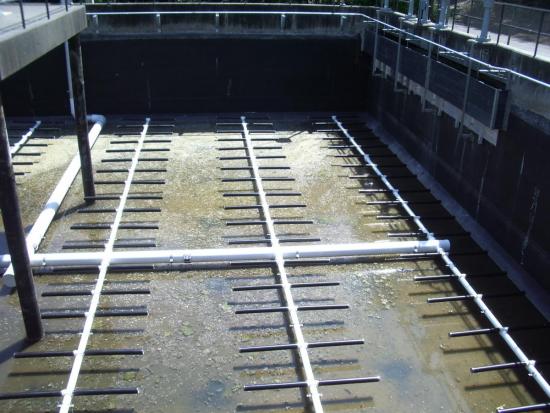By Doreen Tresca, Stamford Scientific International
03/22/2016
The Ilmajoki sewage treatment plant (STP) located in southern Finland was built in the mid-1970s during a boom of infrastructure construction. Over time, industrial presence in the Ilmajoki area grew, and the plant saw an increase in flow of industrial effluent—or liquid waste and sewage. As the amount of influent increased, the plant was no longer able to meet required performance criteria suffered from a severe lack of oxygen—particularly during peak loading times.
The Ilmajoki sewage treatment plant experienced challenges due to industrial effluent coming from both an alcohol production facility and a biogas facility.
Food Plant and Industrial Effluent Sources Cause Spikes
The main treatment challenges were coming from an alcohol production facility and a biogas/waste handling unit located a short distance away from the plant. The liquor facility pre-treats their effluent and generally does not contribute much to the waste at the Ilmajoki STP, however, during maintenance operations, a peak load will occasionally be sent to the wastewater treatment plant.
The biogas facility, on the other hand, did not have a proper pre-treatment facility, and it would flow peak loads into the wastewater treatment plant for 19 hours on a daily basis. The effluent brought in from the biogas facility was nearly 10 times more concentrated than typical municipal flow. The constant and concentrated flows were affecting Ilmajoki’s current processes, and the plant could not keep up. Realizing the plant could not reach government-mandated standardS, the staff realized they had to do something, and quick.
Retrofitting Diffusers for Increased Aeration Capacity
The Ilmajoki STP partnered with Jani Savolainen, Technical Director of Solid Water OY, to design an upgrade to meet the plant’s needs in late 2013. The plant features two aeration tanks, which are able to run in parallel or in series. Each of the two tanks is outfitted with dissolved oxygen (DO) probes for controlling the airflow valves of the downpipes of the tank. Originally when planning the upgrades, it was decided and confirmed that they needed to increase their aeration capacity by 30 percent. To achieve this goal, Mr. Savolainen designed a new system for the plant, which included replacing the 9-year-old discs with 240 pieces of Stamford Scientific International’s (SSI) Snappy Saddle tube diffusers. Paired with the new diffusers were three blowers controlled by a supervisory system for monitoring frequency and constant pressure.
The plant’s two aeration tanks are able to run in parallel or in series.
Stamford Scientific’s Snappy Saddle tube diffusers took the place of the aging disc diffusers along the bottom of the aeration basin. The Snappy Saddle tube diffusers were an ideal choice for the Ilmajoki plant, as each set offers the performance equivalent of five 9-inch disc diffusers. The Snappy Saddle diffusers use one orifice to connect to the air supply, and thus are less likely to leak than standard tube diffusers, which come equipped with two seals. Each Snappy Saddle tube diffuser goes through rigorous quality control at Stamford Scientific’s factory before being sent out to the client. Each membrane is checked for even perforation depth to ensure uniform air release. Through extensive research and development, Stamford Scientific has formulated membranes that contain the right amount of plasticizer—featuring just enough to reduce shrinkage and hardening, while also preventing creep. The Snappy Saddle diffuser is easily installed and mounted by one person, who can use a simple band and wedge system to secure the diffuser on the piping.

The Snappy Saddle from Stamford Scientific offers the performance equivalent of five 9-inch disc diffusers.
The upgrades to the plant were completed in April 2014, and the plant has been running flawlessly since. Since upgrading the diffusers, the plant has seen a vast improvement in influent and effluent quality running through the tanks. At the return activated sludge recirculating aquaculture system (RAS) inlet, the color of the influent—which was initially very dark—has drastically changed for the better. Improvements in effluent color at Ilmajoki were also seen at the channel weir of the clarifier tank (a barrier across a moving body of water) channel.
During the design of the DO control system and consideration of the diffusers, the main goal was to increase the capacity of the plant to handle the peak flows that had troubled them before. Generally, as most people would assume, an increase in capacity would also mean a spike in energy consumption and operating costs of the plant. In the case of Ilmajoki, because of the smart improvements they had made, operators discovered after a few weeks they were actually saving power.
Roberto Amboldi from Stamford Scientific (left) and Jani Savolainen of Solid Water Oy (right) work to address the challenges at the Ilmajoki sewage treatment plant.
Quantifying Energy Savings
In 2012 when the plant was struggling to keep up with regulatory requirements, the Ilmajoki STP was using 4000 kWh per day. Once the new diffusers and control systems were implemented, the plant was able to reduce their consumption and averages to under 2000 kWh per day. With the current cost of power in Finland around .11 Euro per kWh, these savings cumulate up to over 80,000 euro per year. The Stamford Scientific Aeration tube diffusers offered the plant a high-efficiency option for the aeration basins, allowing them to treat substantially more waste than the 9-year-old disc diffuser system. This, paired with a control system customized by Jani Savolainen and the plant operator, allowed the plant to efficiently run their system both at peak loads and during normal flow.
By making a few simple switches and upgrading their aeration basins to Stamford Scientific Aeration’s tube diffusers, the plant was able to make great strides in improving the plant output—in addition to saving money along the way. While upgrading older equipment may seem expensive upfront, over time these improvements for developing a more energy-efficient system will pay for themselves.
About Stamford Scientific International
Stamford Scientific International, Inc., headquartered in Poughkeepsie, New York, has developed and patented multiple advanced membrane technologies, including our PTFE (Polytetrafluoroetyhylene) coated membranes, POD’s factory mounted diffusers, and wireless pipe monitoring systems. PTFE membranes from Stamford Scientific International (SSI) have been installed worldwide in various applications—both municipal and industrial. These membranes have become increasingly popular, as the focus on energy conservation and life-cycle costs has grown worldwide. SSI POD’s diffusers have become a favorite of contractors around the globe, allowing them to reduce installation time by over half. SSI’s wireless pipe monitoring systems allow operators to keep an eye on their plant 24/7 from anywhere in the world and flag any potential issues before they happen.
For more information, contact Doreen Tresca, tel: (845) 454-8171, email: Doreen@stamfordscientific.com, or visit www.stamfordscientific.com.
To read more about the Wastewater Industry, please visit www.blowervacuumbestpractices.com/industries/wastewater.



